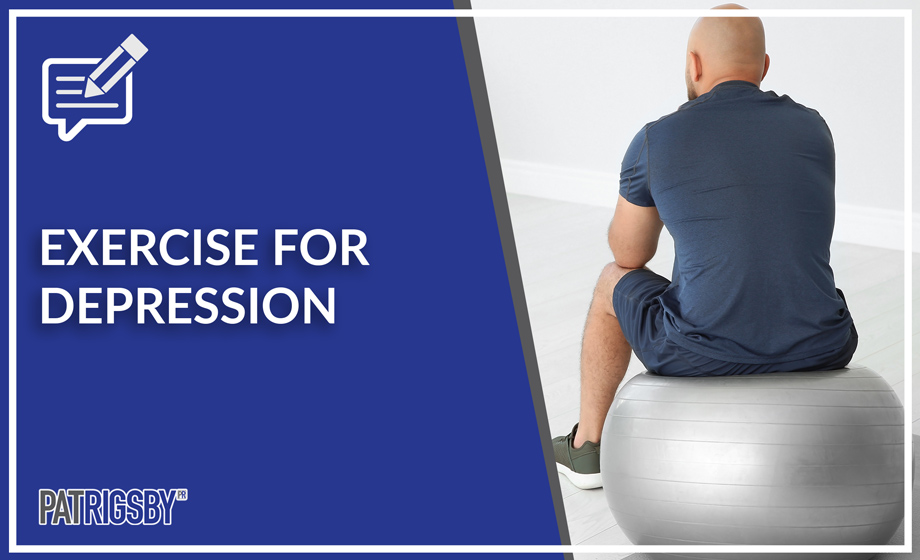By: Igor Klibanov
As a fitness professional, you undoubtedly know how prevalent depression is, and you may even work with people who have it (heck, you might have it yourself). However, there’s very little specific information on how to make it better (other than “exercise is good for you”). And any improvements that come are simply a side effect of exercise. But what if there was a direct way to exercise specifically for depression improvement? What kind of impact would it have on your business?
Would you now be able to send a letter to your client’s doctor, explaining the scientific basis behind your recommendations? Would that help with medical referrals? Would you separate yourself from other trainers? Would you be able to carve a niche for yourself as the “mental health guru” of your community? I’ve done that, and you can too. So let’s jump in.
Do you have clients with depression? If so, you’ll want to read this article, because this is going to be the most thorough, detailed, and comprehensive article on the internet about how to exercise for people with depression.
Your clients might notice that they:
- Have lost pleasure in activities that they really used to enjoy
- Aren’t taking care of themselves as much
- Are neglecting certain relationships
- Performing worse at their work than they used to
Then this article is for you.
A while ago, I wrote an article about exercise for anxiety. The combination of the popularity of that article, plus the fact that lately, I’ve been giving a very large number of talks on exercise for mental health (one of the benefits of being labelled the go-to mental health person in your community) has made me want to now write an article on exercise for depression.
In here, we’ll discuss the exercise prescription for depression. And I use that word, “prescription” very precisely. After all, when a doctor prescribes a medication, there’s a lot of precision behind it. S/he tells you:
- The name of the medication
- The dose
- Whether you should take it with food, or away from food
- Whether you should take it in the morning, or the evening
But when the doctor recommends exercise, well, the recommendation is vague. You don’t know exactly how to do it. You need the exercise prescription for different conditions. To know the exercise prescription you need to know:
- The type: cardio, strength training, or stretching
- The frequency: how many days per week. It’s not always a “more is better” type of scenario. With some things there’s a “sweet spot”
- The duration: how long you exercise for, or how many sets and reps
- The intensity: at what percent of your maximal effort do you exercise?
If you know these details, you have a very precise exercise prescription. And that’s exactly what we’ll cover in this article. After all, just as a doctor wouldn’t prescribe the same medication for every single condition, the same goes for exercise. Exercise for high blood pressure is different than exercise for osteoporosis, which is still different than exercise for diabetes, and so on. Today, you’ll learn about how to exercise for depression relief.
What Is Depression?
So what’s the difference between just general sadness, or a person randomly saying “I’m depressed”, and a true, clinical diagnosis of depression (or the proper term – “Major Depressive Disroder”)? For that distinction, we turn to the DSM 5, which is the Diagnostic and Statistical Manual of Mental Disorders, the “bible” that psychiatrists use for diagnosis.
So according to the DSM 5, for a person to be diagnosed with depression, s/he must:
- Have no other medical conditions, or drugs to which the depression can be attributed
- Cause occupational or social impairment
- Not have any other mental health issue
- Not have had any manic episode or hypomanic episode
- Have at least 5 of these symptoms:
- Depressed most of the day, every day
- Decreased pleasure in activities that used to bring pleasure
- Weight loss or weight gain without trying
- Insomnia or hypersomnia
- Feeling “slowed down”
- Low energy levels
- Feelings of worthlessness or inappropriate guilt
- Unable to think clearly
- Thoughts of death/dying
So now that we’re all on the same page with the definition of depression, let’s examine how to use exercise to reduce the symptoms of depression.
What Type of Exercise for Depression: Cardio or Strength Training?
Although the occasional study finds that cardio is more effective, most studies find no difference in effectiveness between cardio and strength training.
In one study, researchers divided participants into 2 groups:
Group 1 did cardio, 3 times per week, for 1 hour, at an intensity of 80% of their maximal heart rate.
Group 2 did strength training, 3 times per week for 1 hour. They did 10 exercises, in a circuit format, making sure their heart rate did not rise about 50-60% of their estimated maximum.
Group 3: control group. They didn’t exercise.
And yes, both groups 1 and 2 had similar reductions in depression. After the study, around 80% of the people in groups 1 and 2 no longer met the diagnostic criteria for depression. But only 17% of the people in group 3 no longer met the diagnostic criteria for depression. Not bad, eh?
In another study, participants with depression, whose average age was 71 participated in high-intensity strength training, and after 10 weeks, those who were in the exercise group had a 54% reduction in their depression.
How Frequently Should You Exercise for Depression Relief?
That is, how many days per week? Is 1 enough? Is 3 better? Is 5 better? Or is it like medications, where if you don’t take it for one day, the effect completely goes away, in which case, you need to take it every day, 7 days per week?
That’s what this study tried to answer. In here, researchers divided participants into 5 groups:
- Group 1: control group (stretching)
- Group 2: burned 7 kcal/kg/week, across 3 days
- Group 3: burned 7 kcal/kg/week, across 5 days
- Group 4: burned 17.5 kcal/kg/week, across 3 days
- Group 5: burned 17.5 kcal/kg/week, across 5 days
In this case, there was no difference between the 2 groups that burned 7 kcal/kg/week, and the group that didn’t exercise at all. None of those 3 groups saw much of a reduction in depression.
However, both of the groups that exercised at 17.5 kcal/kg/week saw reductions in depression that were similar to each other.
And what were the reductions, exactly?
After 12 weeks of following this program, the reduction in depression symptoms was about 47%.
So what’s our conclusion about frequency? From this preliminary evidence, it seems like there’s not much of a difference between 3 times per week, and 5 times per week, as long as you cross a certain energy expenditure threshold. Is there a greater effect for even greater calorie expenditures? Maybe. But as far as I know, that research has not yet been done, so right now, it’s an “I don’t know.”
What Intensity of Exercise for Depression Reduction?
So now, we know the type (cardio and strength training are about even), the frequency (not much of a difference between 3 and 5 times per week), so what’s the intensity required to reduce depression? Should you take it easy? Or should you really push?
That’s what this study tried to find out.
In that study, researchers divided participants into 3 groups:
Group 1 was a control group (they didn’t exercise)
Group 2 did strength training at 80% of their maximum weight, 3 times per week for 8 weeks.
Group 3 did the exact same exercises, repetitions, and frequency as group 2, but they did it with only 20% of their maximum weight.
The results:
- 21% of the people in group 1 had a reduction in their depression after 8 weeks. Without exercise. Without medication. Without psychotherapy. It just happened.
- 61% of the people in group 2 had a reduction in their depression after 8 weeks.
- 28% of the people in group 3 had a reduction in their depression after 8 weeks
So what’s our conclusion? High intensity is superior to low intensity when it comes to depression reduction.
And yes, this study looked at strength training, but other studies saw the same effect for cardio – high intensity is required to reduce depression.
What about strength training intensity? It also needs to be high. In this study, researchers compared strength training at 80% of participants’ maximal weight against controls (who didn’t exercise). The participants had an average age of 71, and for 10 weeks, they did traditional strength training exercises, 3 times per week, for 3 sets of 8 reps, at 80% of their maximal weight. Each session, the weight was increased as tolerated.
The results: the people in the group that was depressed reduced depression scores by 54%. The people in the control group (who didn’t exercise, but did receive health education in a lecture style) reduced their depression score by only 22%.
So with depression, it’s fairly conclusive that high intensity is necessary to reduce depression. How high is high? Over about 75% of your maximum.
How Long Do You Need to Exercise for Depression Relief?
Is this a case of “more is better”, or is this a case of “just right”? Unfortunately, this variable hasn’t been as well studied as frequency, intensity and type. However, one preliminary study concluded that duration is much less important than frequency and intensity.
In terms of weeks/months, although small, transient reductions are seen with just a single exercise session, to see large, consistent, long-term reductions, you should exercise for at least 9 weeks, according to this study. Although I think that there should be no “end-point” to exercise – it’s a “life sentence” 🙂
Exercise vs. Medications
And now, the million-dollar question: how do medications compare to exercise when it comes to depression relief?
One meta-analysis (a study of several studies), from the journal Frontiers in Pharmacology looked at this question in very significant detail, and found that exercise is equally effective to medications in the treatment of depression. And when the two are combined, the medications work even better.
And yes, exercise has a few bonuses besides depression relief, like:
- Greater endurance
- Greater strength
- Greater flexibility
- Looking better
- Better self esteem
…the same can’t be said for medications. That’s not to say that they shouldn’t be used, but in the risk/reward scale, exercise appears to be superior. Much lower risk, same reward.
The only difference is that it can be difficult to get a depressed person to start exercising, but it is much easier to get them to take a pill. So smart doctors are getting their patients started with the medication, and once there’s some relief, exercise is recommended on top of that.
Which brings me to my next point, of…
How Does it Work?
It’s nice to know what works, but our inner 4-year-old also wants to know “why?” As in “why does exercise help relieve depression?” What are the mechanisms involved?
There are a few explanations:
Reason #1: Endorphins
When you exercise at a high intensity, it’s physically uncomfortable. You’re out of breath, and your muscles are burning. Your body doesn’t like that, so it releases “pain-blocking” chemicals called “endorphins.” So it makes sense why the high intensity is required for depression reduction. It has to be uncomfortable enough to trigger the release of endorphins. Low intensity is too comfortable for endorphin release.
And yes, it blocks physical pain, but along with that, it apparently helps emotional pain, as is seen in depression.
Reason #2: Self Efficacy Hypothesis
Often, a person who suffers from depression has the feeling like their life is out of control. Things are happening to them, and they are helpless against circumstances. Exercise gives you a sense of control. You know that if you go for an intense 20-minute workout, you’ll feel better. And who controls when you work out? You do! Who controls how long you work out? You do! Who controls how hard you work out? You do! So you re-gain the sense of control.
Reason #3: Distraction
Sometimes, exercise just works because you’re focused on how hard you’re breathing, and how much your muscles are burning. You just forget whatever is causing your depression.
Reason #4: Sleep Improvement
It’s very well-known that people who exercise sleep better. And people who sleep better have better mood. So this is yet another mechanism.
Reason #5: Serotonin
Serotonin is the “happy chemical”, and when it’s released, you feel content and relaxed. Guess what helps increase serotonin in the brain? Yep, it’s exercise.
P.S. – 6-Weeks of Coaching…Free.
Get a surge of new clients and revenue over the next 6 Weeks with ZERO FEE and no obligation to continue?
If you’re a current business owner who wants to add 50K or more in annual revenue over the next 12 month, you can Test Drive our coaching program for 6 Weeks with no fee or even an obligation to continue as a way to demonstrate how we can help you grow your business.
No strings attached. No obligation. You get our best coaching & tools…and hopefully, you’ll love it enough that you want to keep working together.
Would you be interested in discussing?
If so, email me here with ‘interested’ in subject line and we’ll set up a chat.










